中美高等教育对比The-Differences-of-Higher-Education-between-China-and-America
中国教育和美国教育的不同英语作文
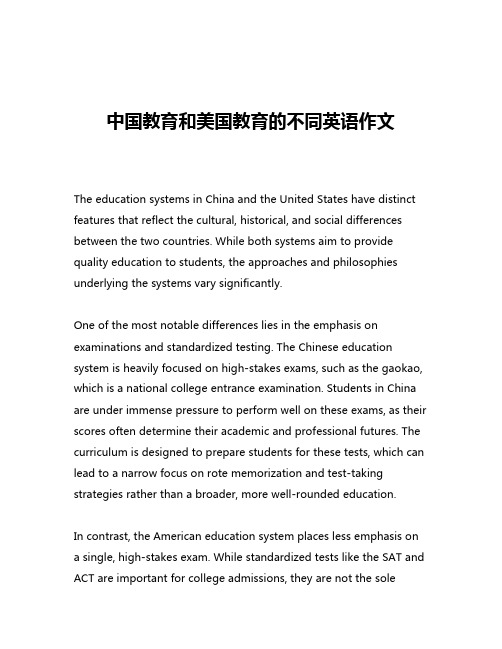
中国教育和美国教育的不同英语作文The education systems in China and the United States have distinct features that reflect the cultural, historical, and social differences between the two countries. While both systems aim to provide quality education to students, the approaches and philosophies underlying the systems vary significantly.One of the most notable differences lies in the emphasis on examinations and standardized testing. The Chinese education system is heavily focused on high-stakes exams, such as the gaokao, which is a national college entrance examination. Students in China are under immense pressure to perform well on these exams, as their scores often determine their academic and professional futures. The curriculum is designed to prepare students for these tests, which can lead to a narrow focus on rote memorization and test-taking strategies rather than a broader, more well-rounded education.In contrast, the American education system places less emphasis on a single, high-stakes exam. While standardized tests like the SAT and ACT are important for college admissions, they are not the soledeterminant of a student's academic success. The curriculum in the United States is generally more diverse, with a greater emphasis on critical thinking, problem-solving, and the development of a wide range of skills and knowledge.Another key difference lies in the role of the teacher. In the Chinese education system, teachers are often seen as authoritative figures who impart knowledge to students. The teacher-student relationship is more formal, and students are expected to respect and obey their teachers. Classroom instruction is typically teacher-centered, with the teacher delivering lectures and students taking notes.On the other hand, the American education system places a greater emphasis on student-centered learning. Teachers are more facilitators of learning, guiding students to discover and construct knowledge for themselves. Classroom activities often involve group discussions, project-based learning, and hands-on activities that encourage students to engage actively with the material.The level of parental involvement in education also differs between the two countries. In China, parents play a crucial role in their children's education, often closely monitoring their academic progress and providing extensive support and guidance. Parental pressure to excel academically is a significant factor in the Chinese education system.In the United States, while parental involvement is encouraged, the level of involvement tends to be more varied. Some parents are heavily involved in their children's education, while others take a more hands-off approach. The American education system also places a greater emphasis on the development of well-rounded individuals, with extracurricular activities and community involvement playing a more significant role.One area where the Chinese and American education systems share some similarities is the increasing focus on STEM (Science, Technology, Engineering, and Mathematics) education. Both countries recognize the importance of developing a strong foundation in these fields to prepare students for the demands of the 21st-century workforce. However, the approaches to STEM education may differ, with the Chinese system placing a greater emphasis on rote learning and mastery of technical skills, while the American system encourages more interdisciplinary and problem-based learning.Despite these differences, both the Chinese and American education systems have their strengths and weaknesses. The Chinese system's emphasis on academic rigor and discipline has produced many high-achieving students, but it has also been criticized for its narrow focus and the immense pressure it places on students. The Americansystem's emphasis on well-rounded education and student-centered learning has produced creative and critical thinkers, but it has also been criticized for a perceived lack of academic rigor.As the world becomes increasingly globalized, there is a growing recognition of the need for a more balanced and integrated approach to education. Both China and the United States can learn from each other's successes and shortcomings, and work towards developing education systems that nurture the holistic development of students while also preparing them for the challenges of the modern world.。
美国教育和中国教育的不同的英语作文
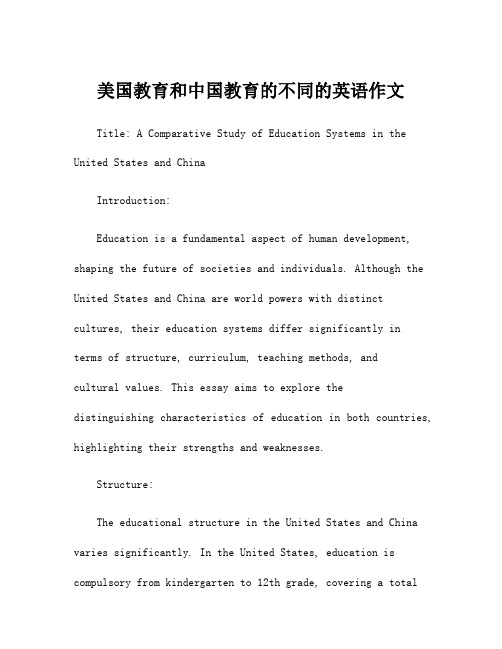
美国教育和中国教育的不同的英语作文Title: A Comparative Study of Education Systems in the United States and ChinaIntroduction:Education is a fundamental aspect of human development, shaping the future of societies and individuals. Although the United States and China are world powers with distinct cultures, their education systems differ significantly in terms of structure, curriculum, teaching methods, andcultural values. This essay aims to explore thedistinguishing characteristics of education in both countries, highlighting their strengths and weaknesses.Structure:The educational structure in the United States and China varies significantly. In the United States, education is compulsory from kindergarten to 12th grade, covering a totalof 13 years. The system is divided into three main levels: elementary school, middle school, and high school. On the other hand, Chinese education is divided into three stages: primary school, middle school, and high school, totaling nine years of compulsory education. Following the nine years, students undertake the rigorous college entrance examination (Gaokao) to gain admission to higher education institutions.Curriculum:Another crucial distinction lies in the curriculum. American education emphasizes a well-rounded education, aiming to develop critical thinking, creativity, and problem-solving skills. This is reflected in a broader curriculumthat includes humanities, arts, sciences, and physical education. In contrast, Chinese education prioritizes core subjects such as mathematics, Chinese language, and sciences. The focus on test preparation and rote memorization often leaves limited room for creativity and individuality.Teaching Methods:Teaching methods play a vital role in shaping students' learning experiences. In the United States, there is a strong emphasis on student-centered learning, promoting active participation, critical thinking, and collaboration. Teachers often incorporate interactive activities, group discussions, and project-based learning to engage students. Conversely, Chinese education leans towards a more teacher-centered approach, with teachers delivering lectures and students primarily expected to listen and take notes. This traditional method aims to impart knowledge efficiently but may hinder the development of independent thinking.Culture and Values:The cultural and societal values of the United States and China significantly influence their respective education systems. In the United States, individualism, competition, and freedom of expression are highly encouraged. Students areoften encouraged to pursue their passions and interests, fostering independence and self-reliance. Conversely, Chinese education emphasizes collectivism, discipline, and respectfor authority. Academic achievement is highly prioritized, reflecting the cultural norm of filial piety and the importance placed on family pride.Conclusion:In conclusion, the education systems of the United States and China differ significantly in structure, curriculum, teaching methods, and cultural values. The American system focuses on holistic development, critical thinking, and individuality, while the Chinese system emphasizes academic rigor and traditional values. Both systems have their strengths and weaknesses, and there is much that can be learned from each other. Ultimately, the goal of education in both countries is to equip students with the knowledge,skills, and values necessary to contribute positively to society.。
中美高等教育差异英语作文
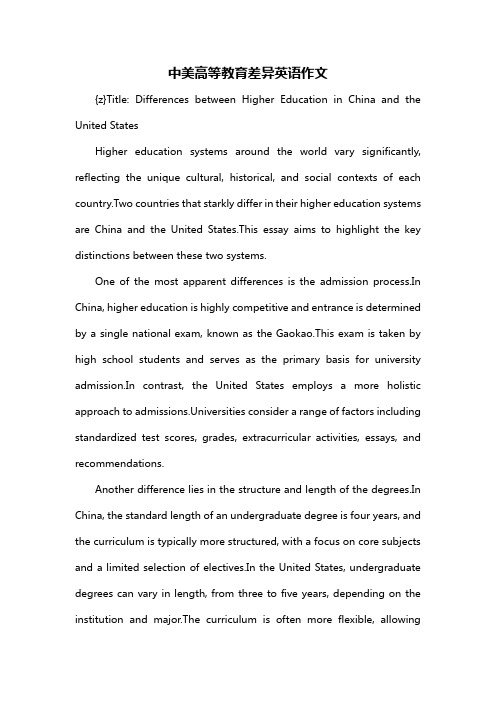
中美高等教育差异英语作文{z}Title: Differences between Higher Education in China and the United StatesHigher education systems around the world vary significantly, reflecting the unique cultural, historical, and social contexts of each country.Two countries that starkly differ in their higher education systems are China and the United States.This essay aims to highlight the key distinctions between these two systems.One of the most apparent differences is the admission process.In China, higher education is highly competitive and entrance is determined by a single national exam, known as the Gaokao.This exam is taken by high school students and serves as the primary basis for university admission.In contrast, the United States employs a more holistic approach to admissions.Universities consider a range of factors including standardized test scores, grades, extracurricular activities, essays, and recommendations.Another difference lies in the structure and length of the degrees.In China, the standard length of an undergraduate degree is four years, and the curriculum is typically more structured, with a focus on core subjects and a limited selection of electives.In the United States, undergraduate degrees can vary in length, from three to five years, depending on the institution and major.The curriculum is often more flexible, allowingstudents to take a broader range of courses outside their major.Furthermore, the concept of academic freedom is more pronounced in the American higher education system.In China, universities often align with government policies and priorities, and there is greater control and regulation over academic content and research.In the United States, universities enjoy more autonomy, encouraging open debate, diverse viewpoints, and innovative research.Moreover, funding and tuition differ significantly.In China, public universities are largely funded by the government, and tuition fees are relatively low.This makes higher education more accessible to a wider range of students.In contrast, tuition fees at American public universities vary by state, but they are generally higher than in China.However, private universities in the United States often offer more financial aid and scholarships, making education more accessible.Lastly, the emphasis on practical experience and internships also differs.Chinese universities often prioritize theoretical knowledge and academic research, with less emphasis on practical experience.In contrast, the American higher education system places a strong emphasis on experiential learning, internships, and practical skills, preparing students better for the job market.In conclusion, there are significant differences between higher education systems in China and the United States.These differencesreflect the unique cultural, historical, and social contexts of each country.Understanding these distinctions can help students make informed decisions about where to pursue their higher education aspirations.。
浅析中美高等教育体制差别
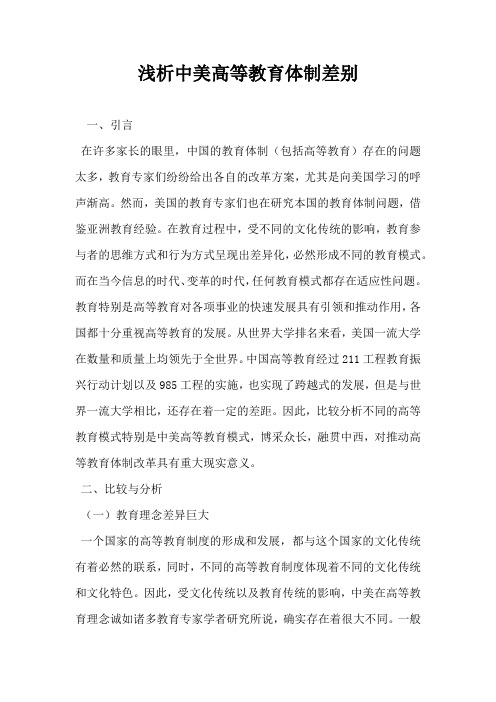
浅析中美高等教育体制差别一、引言在许多家长的眼里,中国的教育体制(包括高等教育)存在的问题太多,教育专家们纷纷给出各自的改革方案,尤其是向美国学习的呼声渐高。
然而,美国的教育专家们也在研究本国的教育体制问题,借鉴亚洲教育经验。
在教育过程中,受不同的文化传统的影响,教育参与者的思维方式和行为方式呈现出差异化,必然形成不同的教育模式。
而在当今信息的时代、变革的时代,任何教育模式都存在适应性问题。
教育特别是高等教育对各项事业的快速发展具有引领和推动作用,各国都十分重视高等教育的发展。
从世界大学排名来看,美国一流大学在数量和质量上均领先于全世界。
中国高等教育经过211工程教育振兴行动计划以及985工程的实施,也实现了跨越式的发展,但是与世界一流大学相比,还存在着一定的差距。
因此,比较分析不同的高等教育模式特别是中美高等教育模式,博采众长,融贯中西,对推动高等教育体制改革具有重大现实意义。
二、比较与分析(一)教育理念差异巨大一个国家的高等教育制度的形成和发展,都与这个国家的文化传统有着必然的联系,同时,不同的高等教育制度体现着不同的文化传统和文化特色。
因此,受文化传统以及教育传统的影响,中美在高等教育理念诚如诸多教育专家学者研究所说,确实存在着很大不同。
一般认为,存在以下几个方面:首先,美国高等教育制度体现出个人主义和实用主义,中国高等教育制度体现出权威主义和功利主义。
美国通过融合原著民以及一系列的战争取得独立成为世界上最大的移民国家,并形成了独特的自由平等的思想,体现在社会生活的各个方面。
而中国是一个有着悠久历史的国家,文化上讲究天人合一,强调群体观念而轻视个人观念。
其次,美国的社会开放多元,美国的高等教育制度兼容并包、灵活多样。
作为历史悠久的文明古国,中国的社会稳定有序,吸纳性强,更强调以我为主,洋为中用。
再次,美国高等教育注重学生对知识的应用与实践,而中国高等教育注重学生对知识的传承和构建。
从另外一个角度看,相对而言,中国的学生比美国的学生更尊重知识和权威,美国的学生比中国的学生对知识和权威更容易质疑。
中美教育差异对比 Comparing the Education Between American and China 中英文

Comparing the Education Between American and China1. Education in China and the United States first of all the differences between the two countries is the primary goal of teaching different:Chinese primary education to children's intellectual development, child benefits as a high priority goal.And China's education emphases on training the students to be strict,rigorous spiritual.In the United States, there is only one primary purpose: to cultivate children's creativity. And US's education pays more attention to raise student's self-confidence,independence,spirit of supporting oneself.中国与美国教育的差异首先在于两国初等教育的教学目标不同:中国初等教育将开发孩子的智力,孩子好处高分看成首要目标,而且中国的教育强调培养学生成为严格严谨的精神。
在美国,初等教育的目的只有一个:培养孩子的创造力。
美国的教育注重培养学生的自信心、独立、精神支持自己。
paring the elementary education between American and China, people's universal view will be:China's elementary education aims to build the foundation of education with more study and less thought.US's education aims to bulid such an education to raise the creativity with less study and more thought.比较基础教育在美国和中国人们的普遍观点:中国的基础教育旨在建立基础教育同更多的学习和更少的想法。
中美高等教育差异英语作文

中美高等教育差异英语作文English:The differences between higher education systems in China and the United States are quite significant. In China, the educational system is more structured and focused on exams and memorization, with lectures being the primary mode of instruction. Students in China often have limited opportunities to engage in discussions, critical thinking, and hands-on learning experiences. On the other hand, the higher education system emphasizes critical thinking, creativity, and practical applications of knowledge. Classes in the typically involve smaller group discussions, group projects, and interactive learning activities that encourage students to think independently and develop problem-solving skills. Additionally, there is a greater emphasis on extracurricular activities, internships, and research opportunities in the , allowing students to gain practical experience and develop essential skills outside of the classroom.中文翻译:中国和美国高等教育系统之间的差异相当显著。
中美高中教育差异英语作文

中美高中教育差异英语作文The Differences between Chinese and American High School Education。
Education is an important part of every country's development. It shapes the future generation and influences the overall progress of a nation. In this essay, I will discuss the differences between Chinese and American high school education.Firstly, let's talk about the curriculum. In China, the high school curriculum is heavily focused on core subjects such as Chinese, mathematics, and English. Students are required to take a wide range of subjects, and there is a strong emphasis on memorization and rote learning. On the other hand, the American high school curriculum is more flexible. Students have the opportunity to choose their own subjects, and there is a greater emphasis on critical thinking and problem-solving skills.Secondly, the teaching style is also different. In China, teachers are seen as authority figures, and students are expected to listen and follow instructions. The classroom environment is often very formal, and there is little room for discussion or debate. In contrast, American high school classrooms are more interactive. Teachers encourage students to ask questions and express their opinions, and there is a greater focus on group work and collaborative learning.Another key difference is the assessment system. In China, students are evaluated based on standardized tests, and there is a strong emphasis on academic achievement. This can create a lot of pressure for students, as their entire future may depend on their performance in these exams. In the US, assessment is more holistic. Students are evaluated based on a combination of tests, projects, and class participation, and there is a greater focus on personal development and growth.Furthermore, extracurricular activities play adifferent role in the two systems. In China,extracurricular activities are often seen as a distraction from academic studies, and there is less emphasis on developing skills outside of the classroom. In the US, extracurricular activities are an important part of the high school experience. Students are encouraged to participate in sports, music, drama, and other activities, and there is a greater focus on developing well-rounded individuals.Finally, let's talk about the overall goal of high school education. In China, the main goal of high school education is to prepare students for the Gaokao, the national college entrance examination. Success in this exam is seen as the key to a bright future, and there is a strong focus on academic achievement. In the US, the goal of high school education is to prepare students for college and beyond. There is a greater emphasis on developing critical thinking, creativity, and communication skills, and the focus is on preparing students for a successful and fulfilling life.In conclusion, there are many differences betweenChinese and American high school education. These differences reflect the broader cultural and societal values of each country, and they have a significant impact on the development and future success of students. It is important to recognize and understand these differences in order to create an education system that best serves the needs of our future generation.。
写一篇中美高中教育差异的英语作文
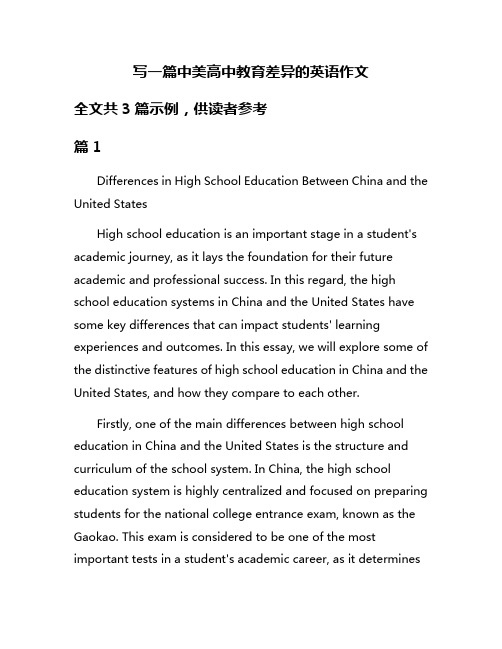
写一篇中美高中教育差异的英语作文全文共3篇示例,供读者参考篇1Differences in High School Education Between China and the United StatesHigh school education is an important stage in a student's academic journey, as it lays the foundation for their future academic and professional success. In this regard, the high school education systems in China and the United States have some key differences that can impact students' learning experiences and outcomes. In this essay, we will explore some of the distinctive features of high school education in China and the United States, and how they compare to each other.Firstly, one of the main differences between high school education in China and the United States is the structure and curriculum of the school system. In China, the high school education system is highly centralized and focused on preparing students for the national college entrance exam, known as the Gaokao. This exam is considered to be one of the most important tests in a student's academic career, as it determineswhich universities they can attend and what majors they can study.On the other hand, the American high school education system is more diverse and flexible, with students having the option to choose from a wide range of subjects and extracurricular activities. High schools in the United States also emphasize holistic development, with a focus on critical thinking, creativity, and problem-solving skills. Additionally, students in the United States have the freedom to choose their own path and explore their interests through elective courses and extracurricular activities.Another key difference between high school education in China and the United States is the teaching methods and classroom culture. In China, the teaching style is more traditional and teacher-centered, with an emphasis on rote memorization and passive learning. Students are expected to listen attentively to the teacher and take notes, without much room for discussion or critical thinking.In contrast, the American high school education system promotes active learning and student engagement, with teachers encouraging students to ask questions, participate in class discussions, and work collaboratively on projects. Theclassroom culture in the United States is more democratic, with students having the opportunity to express their opinions and ideas freely.Furthermore, the assessment and grading systems in high school education also differ between China and the United States. In China, students' academic performance is primarily evaluated based on their scores in exams and tests, with a strong emphasis on academic achievement and competitiveness. Grades play a crucial role in determining students' future academic and professional opportunities.In comparison, the American high school education system uses a more holistic approach to assessment, taking into account students' participation, creativity, and critical thinking skills in addition to their academic performance. Grading in the United States is often based on a combination of tests, essays, projects, and presentations, with an emphasis on overall learning and growth rather than just test scores.In conclusion, high school education in China and the United States have some distinct differences in terms of structure, curriculum, teaching methods, classroom culture, and assessment systems. While the Chinese education system is more centralized and focused on academic achievement, theAmerican education system is more diverse, flexible, and student-centered. Both systems have their strengths and weaknesses, and it is important for educators to recognize and learn from each other in order to provide the best possible education for students in both countries.篇2The differences between high school education in China and the United States are quite significant. These two educational systems have different priorities, methodologies, and overall structures. In this essay, I will explore some of the key differences between Chinese and American high school education systems.One major difference between Chinese and American high school education is the emphasis on standardized testing. In China, students must take the infamous "gaokao" exam to gain entrance into university. This exam is highly competitive and determines a student's future academic path. On the other hand, in the United States, while standardized testing is still important, there is more emphasis on a student's overall academic performance, extracurricular activities, and personal essays when applying to college.Another key difference is the teaching methodologies used in Chinese and American high schools. In China, students are typically taught through rote memorization and lectures. There is little room for creativity or independent thinking in the classroom. In contrast, American high schools often emphasize critical thinking, problem-solving, and project-based learning. Students are encouraged to think outside the box and explore their own interests and passions.Furthermore, the overall structure of high school education in China and the United States also differs. In China, high school students have a rigorous schedule with long hours of studying and homework. There is a strong emphasis on academic success and competition. American high schools, on the other hand, offer more flexibility and opportunities for students to pursue extracurricular activities, sports, and interests outside of the classroom.Overall, while both the Chinese and American high school education systems have their strengths and weaknesses, it is clear that they prioritize different values and goals. Chinese education focuses on academic success and achievement, while American education values creativity, critical thinking, and personal growth. By understanding the differences betweenthese two systems, educators and policymakers can work towards creating a more balanced and effective approach to high school education that benefits students from both countries.篇3US and China are two countries with very different education systems, and this is especially evident in the high school level. In this essay, we will explore some of the key differences between high schools in the US and China.One of the biggest differences between high schools in the US and China is the focus on standardized testing. In China, students are expected to take a series of rigorous exams, such as the Gaokao, which determines which university they can attend. These exams are extremely high-stakes and play a major role in a student's future prospects. In contrast, standardized testing in the US, such as the SAT and ACT, is just one of many factors considered in college admissions.Another key difference is the teaching methods used in high schools. In the US, there is a greater emphasis on critical thinking, creativity, and student-centered learning. Teachers encourage students to think for themselves, ask questions, and engage indiscussions. In China, on the other hand, the focus is on rote memorization and learning from textbooks. Students are expected to absorb large amounts of information and regurgitate it on exams.The structure of high schools also differs between the two countries. In the US, high schools typically have a more flexible schedule, with students choosing their own classes and extracurricular activities. This allows students to explore their interests and talents. In China, high schools have a more rigid structure, with a set curriculum and limited opportunities for elective courses.The role of extracurricular activities is another area where US and Chinese high schools diverge. In the US, extracurricular activities play a significant role in a student's education, with many students participating in sports, music, drama, and other clubs. These activities help students develop important skills such as teamwork, leadership, and time management. In China, extracurricular activities are often seen as a distraction from academics and are given less importance.Overall, high schools in the US and China have very different approaches to education. While the US emphasizes critical thinking, creativity, and individuality, China focuses on rotememorization, standardized testing, and academic achievement. Both systems have their strengths and weaknesses, and there is much that each country can learn from the other. By understanding and appreciating these differences, we can work towards creating a more effective and balanced education system for students in both countries.。
中美高等教育比较与分析
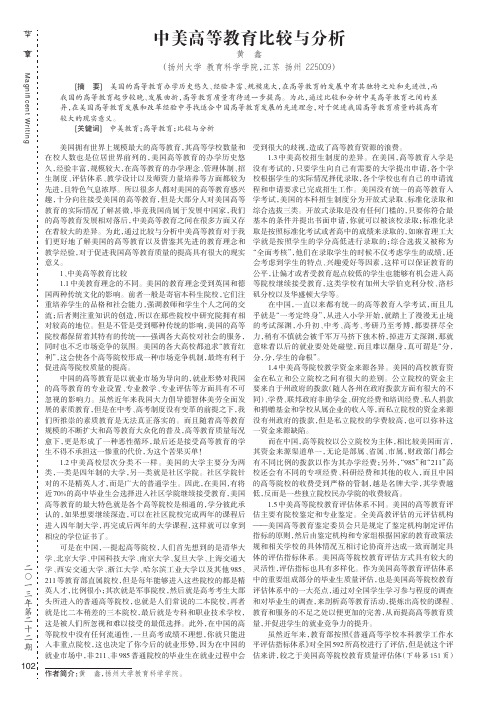
由此而正确掌握日语。
[4]沈国威.近代日中語彙交流史.笠間書院,1994.
综上所述,中日同形语具有多方面的特点,要完全解释中
[5]相原茂,荒川清秀,大川完三郎.東方中国語辞典[M].東方書店,
日同形语的不同点是有难度的,同时,因学习者的理解能力,接 2004.
受能力的不同,作为日语教师应该根据学生的理解能力,接受
们更好地了解美国的高等教育以及借鉴其先进的教育理念和 学就是按照学生的学分高低进行录取的;综合选拔又被称为
教学经验,对于促进我国高等教育质量的提高具有很大的现实 “全面考核”,他们在录取学生的时候不仅考虑学生的成绩,还
意义。
会考虑到学生的特点、兴趣爱好等因素,这样可以保证教育的
1、中美高等教育比较
公平,让偏才或者受教育起点较低的学生也能够有机会进入高
而出现很多中国式的日语。在日常的教学中,我们该如何教给 形语,以寻求更加完美的掌握和运用中日同形语的方法。
学习者,教的重点是什么,有必要注意以下几个方面:(1)让学
【注 释】
习者了解词语是否是中日同形语;(2)让学习者了解同形语在
①汉语简体字以及所对应的日语繁体字.
汉语和日语中的意思,用法,语感的相同点和不同点;(3)让日 语学习者了解日语中的汉字被日本人赋予的新含义;(4)让学 习学习者了解在读解文章或者写作的时候同形语该如何正确
团队精神:现代化科研的难度不断增加,研究规模迅速扩
献身精神:从事发明创造,需要有崇高的理想,无畏的勇 大。学科间的相互渗透日趋明显,学科间的界限逐渐模糊,单
气。献身的精神。马克思曾把“科学的入口处”比喻为“地狱的 靠一个人、一项专业难有所作为,而要依靠集体智慧和力量。
入口处”。没有献身精神是不可能创新业的。
中美高中教育比较英文作文

中美高中教育比较英文作文High school education plays a crucial role in shaping the future of young individuals, preparing them for the challenges and opportunities that lie ahead. When it comes to the education systems of China and the United States, there are both similarities and distinct differences that are worth exploring. This essay aims to provide a comprehensive comparison of the high school education in these two countries, highlighting the key aspects that contribute to their respective educational landscapes.One of the most significant differences between the high school education systems in China and the United States lies in the approach to curriculum and academic focus. In China, the high school curriculum is typically more rigorous and centered around core academic subjects, such as mathematics, science, and language arts. Students are expected to excel in these subjects, as their performance on national standardized exams, such as the Gaokao, largely determines their future educational and career opportunities. The emphasis on academic achievement is deeply ingrained in the Chinese educational culture, and students often devote long hours tostudying and preparing for these high-stakes examinations.In contrast, the high school education in the United States tends to be more well-rounded, with a greater emphasis on a diverse range of subjects, including the arts, humanities, and extracurricular activities. American high schools often provide students with the flexibility to explore their interests and passions, allowing them to tailor their academic experiences to their individual needs and goals. While there is still a strong focus on core academic subjects, American high schools also encourage students to engage in elective courses, clubs, and community service, which can contribute to their personal growth and development.Another key difference between the two education systems is the role of standardized testing. In China, the Gaokao is the pivotal national exam that determines a student's access to higher education institutions. The intense pressure and competition surrounding the Gaokao have led to a strong emphasis on test preparation and rote learning, often at the expense of critical thinking and creative problem-solving skills. In the United States, while standardized tests like the SAT and ACT play a significant role in the college admissions process, they are not the sole determinant of a student's academic potential. American high schools typically incorporate a more holistic approach, considering factors such as extracurricular activities, letters of recommendation, and personal statements in the admissionsprocess.Another notable difference lies in the teaching methodologies employed in Chinese and American high schools. Chinese high school classrooms are often characterized by a more teacher-centered approach, where the instructor delivers lectures and students are expected to absorb the information presented. This teaching style emphasizes the mastery of subject matter and the ability to reproduce knowledge on exams. In contrast, American high schools have increasingly adopted student-centered learning approaches, which encourage active engagement, critical thinking, and collaborative problem-solving. Teachers in the United States often utilize various instructional methods, such as group discussions, project-based learning, and hands-on activities, to foster a more dynamic and interactive learning environment.Despite these differences, there are also some similarities between the high school education systems in China and the United States. Both countries place a strong emphasis on the development of core academic skills, such as proficiency in mathematics, science, and language arts. Additionally, both education systems recognize the importance of preparing students for the next stage of their educational or professional journeys, whether it be college, vocational training, or the workforce.Moreover, both China and the United States have made efforts to address the challenges and evolving needs of their respective high school education systems. In China, there have been initiatives to promote more holistic and well-rounded education, encouraging the development of critical thinking, creativity, and practical skills. Similarly, in the United States, there have been ongoing efforts to address issues such as achievement gaps, college readiness, and the integration of technology in the classroom.In conclusion, the comparison of high school education between China and the United States reveals a complex and multifaceted landscape. While the two countries have distinct approaches and priorities, both systems share the common goal of preparing students for success in their future endeavors. By understanding the unique characteristics and strengths of each system, educators and policymakers can engage in meaningful dialogue and exchange of best practices, ultimately enhancing the educational experiences of high school students in both countries.。
中美大学教育比较
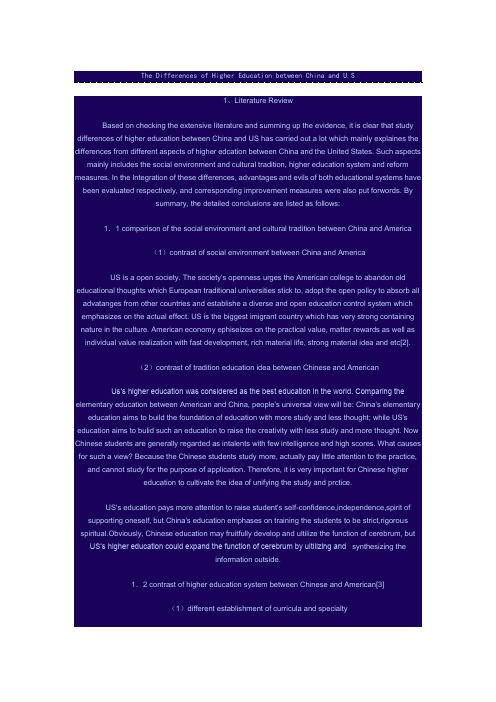
The Differences of Higher Education between China and U.S1、Literature ReviewBased on checking the extensive literature and summing up the evidence, it is clear that study differences of higher education between China and US has carried out a lot which mainly explaines the differences from different aspects of higher edcation between China and the United States. Such aspects mainly includes the social environment and cultural tradition, higher education system and reform measures. In the Integration of these differences, advantages and evils of both educational systems have been evaluated respectively, and corresponding improvement measures were also put forwords. Bysummary, the detailed conclusions are listed as follows:1.1 comparison of the social environment and cultural tradition between China and America(1)contrast of social environment between China and AmericaUS is a open society. The society's openness urges the American college to abandon old educational thoughts which European traditional universities stick to, adopt the open policy to absorb all advatanges from other countries and establishe a diverse and open education control system which emphasizes on the actual effect. US is the biggest imigrant country which has very strong containing nature in the culture. American economy ephiseizes on the practical value, matter rewards as well as individual value realization with fast development, rich material life, strong material idea and etc[2].(2)contrast of tradition education idea between Chinese and AmericanUs’s higher education was considered as the best education in the world. Comparing the elementary education between American and China, people's universal view will be: China's elementar y education aims to build the foundation of education with more study and less thought; while US's education aims to bulid such an education to raise the creativity with less study and more thought. Now Chinese students are generally regarded as intalents with few intelligence and high scores. What causes for such a view? Because the Chinese students study more, actually pay little attention to the practice, and cannot study for the purpose of application. Therefore, it is very important for Chinese higher education to cultivate the idea of unifying the study and prctice.US's education pays more attention to raise student's self-confidence,independence,spirit of supporting oneself, but China's education emphases on training the students to be strict,rigorous spiritual.Obviously, Chinese education may fruitfully develop and ultilize the function of cerebrum, but US’s higher education could expand the function of cerebrum by ultilizing and synthesizing theinformation outside.1.2 contrast of higher education system between Chinese and American[3](1)different establishment of curricula and specialtyEach national higher education as economic system’s reflection serves for the economy; US education aims to adapt for society demand, they explicitly stipulate three big functions including education’s service for the economic development, scientific research and teaching. The manifest of service in the establishment of specialty curriculum is to meet the social need, set up special curriculum and specialty which the society needs; In China's universities, during quite long period of time, the establishment of specialty curriculum lacks the change and couldnot follow social demand.(2)different choice of specialty curriculaIn order to adapt the society, the American universities has established many specialties and curriculum of choice for students; The students choose or transformate specialties and schools according to own interest and hobby. The American higher education system is extremely diverse and flexible, which is solo in the world higher education; In China, the student may choose the specialty according to own interest and hobby, but change of specialty in the school is not easy, and transformation of school ismore difficult.(3)different styles of inspecting students’ resultsWhen American school inspects the result of student, they emphasize more on the ability to analyze and solve the question but not the ability of memory or description. The American students donot need the mechanical memorizing, but display creative thought as far as possible; This can cultivate student's study interest, raise the ability of doing it byself and make the study be one kind of creative action.Many teachers still adopted old teaching ways in the Chinese universities, thus take a test whichneeds mechanical memorizing.2、The purpose and meaning of topicsDue to the development of science and technology, connections between higher education and national politics, economy, science,culture, military relation is day by day closer. The higher education is vigorous and upward, and it not only simply performances for the growth of quantity, but especially has had the huge change in the nature[1]. The advanced level of higher education has become a thesymbolof national strength.We should clarify the difference of higher education between China and American, at the same time absorb the advantges to profit from the American higher education so as to faster the reform andthedevelopment of our higher education.3、Papers outlineThe outline of this paper has been arranged as follows:(1)Summary:reference summary,purpose and meanings for this paper,main idea in thispaper and etc(2)The differences of higher education between China and U.S(a). comparison of the social environment and cultural tradition between China and America1. contrast of social environment between China and America2. contrast of tradition education idea between Chinese and American(b). contrast of higher education system between Chinese and American1. different establishment of curricula and specialty2. different choice of specialty curricula3. different styles of inspecting students’ result4. Differences between public and private schools5. differences of styles of moral and ethical education(c). differences of graduates’ ability between China and U.S.1. The similarity of training objectives2. The difference between the actual train personnel(d). The difference of reform measures1. reform measures in US2. reform measures in China(3) Enlightenment of American higher education on Chinese education(a). Establish a people-oriented education idea(b). Teaching management should be institutionalized and flexible.(c). Teaching should highlight the main participatory(d). Build a pluralistic evaluation system of students(e). Improve the overall quality, to achieve the perfect combination of personality and common4. Writing ProgramThe Writing Program should be arranged as follows:(1). Summary:reference summary,purpose and meanings for this paper,main idea in this paperand etc(2). The differences of higher education between China and U.S(3). Enlightenment of American higher education on Chinese education5. References[1]. Shi Jing-huang,Contemporary American Education[M],Beijing:Social Science LiteraturePublishing House,2004[2]. Li Ze-tong,Perspective of US[M],Beijing: Foreign Economic and Trade University Press,2003[3]. Yuan Yan-xi,Exploration of modern education reform[M],Beijing: People's EducationPress,1987[4]. Duan run-bao,Sino-U.S. differences and the tertiary industry of higher education[J],HebeiTechnology collges press,2002,5[5].Yang-yang,comparement between China and US and its thought[J],A-bei normal universitypress,2009,9。
中美高等教育差异英语作文
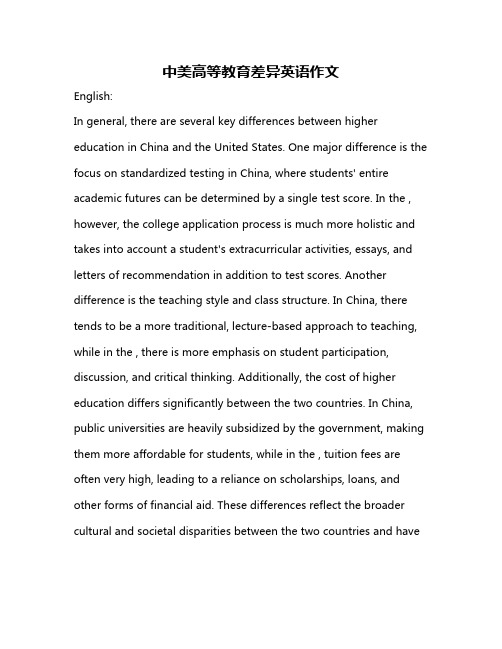
中美高等教育差异英语作文English:In general, there are several key differences between higher education in China and the United States. One major difference is the focus on standardized testing in China, where students' entire academic futures can be determined by a single test score. In the , however, the college application process is much more holistic and takes into account a student's extracurricular activities, essays, and letters of recommendation in addition to test scores. Another difference is the teaching style and class structure. In China, there tends to be a more traditional, lecture-based approach to teaching, while in the , there is more emphasis on student participation, discussion, and critical thinking. Additionally, the cost of higher education differs significantly between the two countries. In China, public universities are heavily subsidized by the government, making them more affordable for students, while in the , tuition fees are often very high, leading to a reliance on scholarships, loans, and other forms of financial aid. These differences reflect the broader cultural and societal disparities between the two countries and havea significant impact on the educational experiences of students in both countries.中文翻译:一般来说,中国和美国的高等教育有几个关键的不同之处。
中美高等教育对比The-Differences-of-Higher-Education-betwee
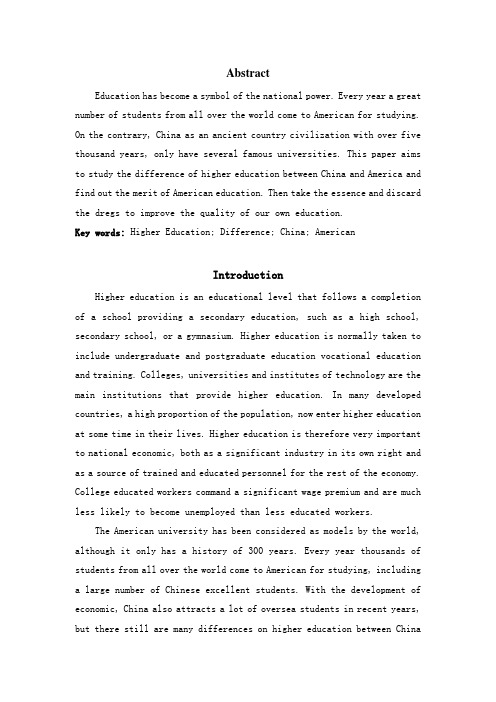
AbstractEducation has become a symbol of the national power. Every year a great number of students from all over the world come to American for studying. On the contrary, China as an ancient country civilization with over five thousand years, only have several famous universities. This paper aims to study the difference of higher education between China and America and find out the merit of American education. Then take the essence and discard the dregs to improve the quality of our own education.Key words: Higher Education; Difference; China; AmericanIntroductionHigher education is an educational level that follows a completion of a school providing a secondary education, such as a high school, secondary school, or a gymnasium. Higher education is normally taken to include undergraduate and postgraduate education vocational education and training. Colleges, universities and institutes of technology are the main institutions that provide higher education.In many developed countries, a high proportion of the population, now enter higher education at some time in their lives. Higher education is therefore very important to national economic, both as a significant industry in its own right and as a source of trained and educated personnel for the rest of the economy. College educated workers command a significant wage premium and are much less likely to become unemployed than less educated workers.The American university has been considered as models by the world, although it only has a history of 300 years. Every year thousands of students from all over the world come to American for studying, including a large number of Chinese excellent students. With the development of economic, China also attracts a lot of oversea students in recent years, but there still are many differences on higher education between Chinaand America.As a result, we should learn from America and make improvement in our education.I The Differences of Higher Education between China and AmericaFirstly, they are different in teaching methods.In American, inspiring students is great important for teaching. In classroom, teachers will specially put forward some inspiring questions for students. In such a teaching mode, students in the classroom have a higher degree of freedom, and they can be ready to make their own doubt for teachers which made the teaching atmosphere lively and vivid. This method of teaching helps students develop the ability of independent thinking and solving problem. However, China’s higher education pays more attention to the systematic study. When teaching the curriculum, teachers should follow in accordance with certain teaching programs. Although students have certain interactive questions, this kind of questions tend to be concentrated after the class, rather than in the classroom. It is the main mode that class is taught by teachers and students just listen to the records. This approach is conductive to help the students learn systemic knowledge, and they have less sense of innovation.Secondly, they have differences in the dependence of students. In America, college students are likely to be more independent of their parents. Students often make decisions by themselves, no matter on studying and live. And students are often expected, as part of learning to be an adult, to pay for part or all the costs of college by themselves. On the other hand, pa rents also give more freedom for children to the best of their abilities. Some American college students thrive in this new found freedom, and some flounder. Many grow up quickly during college, while others fail and leave college to find full-time jobs. In China, college students are likely to be their parents’ only child—the focus of family pride, concern, and hope. Their parents’ work hard to help them succeed, including helping them study for the dreaded college entrance exams. And parents try their best to teach traditional Confucian valuesof honoring family, teacher, and education and the modern realities of rapidly expanding commerce and technology.Thirdly, they have different targets. In American, every university has its reasons to exist, no matter how small it is. And each university knows what their target is. For example, the economic institute of Stanford university has three goals for undergraduate. There is no doubt the number of universities in China is increasing but most university don’t know why it should be established and exists. Just because China has a large population, more universities can let more students go to the university. In addition, the development of Chinese universities behaves a bit impulsive, for example, many universities are seeking for certain “world rankings” but overlook the for mal development of themselves. And most of students choose to go to university is to get a diploma which can help them find a job easily.II The Reasons for the DifferencesChina and America has different social environment. America is open social. The society’s openness urges the American college to abandon the old education on thought which European traditional university sticks to, adopts open policy to absorb all advantages from other countries and establishes diverse and open education control system which emphasizes the actual effects. America is the biggest immigrant country which has very strong containing nature in the culture. American economy emphasizes on the practical value, matter reward as well as individual value realization with fast development, rich material life, strong material idea and etc. The American advocates the independent way of life and work. The American owns full creative humanities spirit, the innovation is the forever subject in their brains. They pursue the high-tech and prefer to compete.Contrast with young American, China is the great nation with glorious history and cultural traditions. The Chinese people have the excellent moral of modesty, rigorous and implicit, but also have been over cautious and conservative. Through Chinese economy and technology is quite backward, it has very strong potential development. Therefore, China implements the policy of opening up, abundantly absorbs the benefit and enriches itself.Besides, Education is a cultural phenomenon, different education response to a different culture. So we can see the cultural difference in the view of higher education. From ancient on, Chinese people are always very conservative, which result in they lack of spirit of adventure and innovative conscious. As a result, the student in the classroom is not very active. By contrast, America is a nation of immigrants with a short history. With the influence of multi culture and different values, it is easy for them to be more lively and free.III Enlightenment from the Concept of American Higher EducationNowadays, China’s higher education is shift from the examination-oriented education to quality education. Indeed what kind of education principles and practices to choose is not only related to quality of education, but related to the future of the Chinese nation and all young students’ life development. The reform of higher education should respect history and national conditions with compatible absorption and innovation. Here is some enlightenment from the concept of American higher education.Firstly, teaching management should achieve the reunification of system and flexibility. Teaching management system is a set of regulations and criterions to ensure the normal functioning of teaching andextracurricular life. In thedevelopment of teaching management system, standard and uniformity nature of the system if often focused, while the humanities, reasonableness and flexibility is consider insufficiently.Secondly, students’sense of participation should be fully prominent in teaching practice. The stress of individualized education is to awaken and mobilize students’main principle, promote students’initiative and creativity. It not only emphasizes the lead role of teachers in the process of teaching, but also give the main role to students in the process of learning. Therefore, teaching should focus on taking individualized teaching methods, strategies and techniques, widely apply the science teaching methods.Furthermore, our education system should have appropriately change. Every university should adjust its direction and position in a timely manner with the social development, so that it keep pace with the times, and successfully transform the university into a higher level.ConclusionFrom what has mentioned above we know the differences of higher education between America and China as well as its reason. There is no point saying which kind of education is superior. We should improve ourselves continuously only if we could find out our weaknesses in this comparison and learn from the best. American higher education is the heaven for the students to learn what they like and what they need actually. Higher education in China is continuously growing, changing and developing.Higher education in China has played a significant part in economic growth, scientific progress and social development in the country by bringing up large scale of advanced talents and experts for the construction of socialist modernization. At the end of the paper lists some enlightenment from the concept of American higher education. If we can follow these changes, Chinese higher education will go to a brightfutureand American also can get something they lack of from our higher education.(注:可编辑下载,若有不当之处,请指正,谢谢!)。
中美高等教育评估比较
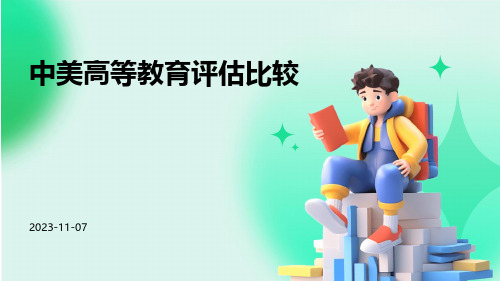
2023-11-07CATALOGUE目录•引言•中美高等教育评估体系概述•中美高等教育评估指标比较•中美高等教育评估结果与使用•中美高等教育评估发展趋势与建议•结论与展望01引言背景介绍中国和美国是世界上最大的两个高等教育系统,各自拥有独特的高等教育评估体系。
近年来,中美两国的高等教育评估均在不断改革和发展中,但彼此间的比较研究相对较少。
通过对比分析中美两国高等教育评估体系的异同,可以为改进两国高等教育质量提供参考和借鉴。
目的了解中美两国高等教育评估体系的现状、特点和问题,分析其背后的原因和影响因素。
意义为改进中美两国高等教育质量、促进教育公平和发展提供参考和借鉴,同时也有助于增进两国高等教育的交流与合作。
研究目的和意义研究方法和数据来源方法采用文献资料法、比较分析法、案例研究法等多种研究方法,对中美两国的高等教育评估体系进行深入比较和分析。
数据来源主要来源于中美两国高等教育评估相关的政策法规、官方数据、学术论文、研究报告等。
02中美高等教育评估体系概述中国的高等教育评估始于20世纪90年代,经过几十年的发展,已经成为保障高等教育质量的重要手段。
评估历史中国的高等教育评估旨在提高教育质量,促进学校发展,增强学生综合素质,以及适应社会需求。
评估目的中国的高等教育评估主要采用定量和定性相结合的方法,包括数据分析、学校自评、专家评审、社会参与等。
评估方法中国的高等教育评估标准包括办学条件、学科建设、教学质量、科研水平、社会服务等多个方面。
评估标准美国的高等教育评估始于20世纪初,经过百年的发展,已经成为保障高等教育质量的重要机制。
评估历史评估目的评估方法评估标准美国的高等教育评估旨在提高教育质量,促进学校发展,满足学生需求,以及适应社会变化。
美国的高等教育评估主要采用定性方法,包括学校自评、专家评审、学生参与等。
美国的高等教育评估标准包括教育质量、学生满意度、科研水平、社会影响力等多个方面。
03中美高等教育评估指标比较教学质量评估指标比较教学质量评估指标中国高等教育评估中,教学质量是评估的重要指标之一。
中美高等教育比较

摘要:中国和美国两个国家高等教育的发展和现状为什么会不一样呢,是否与其历史、国家体制、政治、经济等情况有关呢?中国正常按照年代来估算的话,高等教育不是应该相对于美国的高等教育质量要高吗?那么为什么美国高校的排名在世界上都位居前排,而中国就算是清华、北大都要在二百以外呢?关键词:中国高等教育、美国高等教育、比较、发展教育是一国之本,高等教育在一个国家的经济、政治、科研、文化等领域中占有重要地位,而随着社会的进步,一个国家教育的发达情况不仅仅是看这个国家高校的数量,更看重的质量。
为什么我国高等教育就要相对于美国要落后呢?下面就进行一下分析.一、历史发展的比较美国的高等教育要从殖民地时期开始(1492年),那时的美国高等教育是属于宗教性质的,为了英国等殖民者传播自己教义.但是他们的学校不是由教会负责,而是由地方负责,他们的这种状况形成了美国日后的地方负责制。
正在美国独立战争后,美国出现了第一批高等教育机构,分为公立和私立,他们发展的都很艰难。
在中国,高等教育可以分为七个时期,第一时期是甲午战争以前(1862--1894年),处于酝酿时期,主要培养军事,技术和语言等人才,主要是效仿西方。
第二时期是1895年到1911年,这一时期是中国近代大学的雏形时期,主要以日本为模板的。
第三时期是清朝被推翻后(1912至1927年),中国刚结束封建帝制,是中国高等教育发展的多元化时期,颁布了各种有关高等教育的法规法令,这一时期蔡元培的仿德学制是很出名的,蔡元培的理念就是学术自由和教授治校.第四时期是1927至1949年,这一时期主要以美国模式为基本走向,期间有仿照美国的大学区制,但是仅有两年就无疾而终。
第五时期是1949至1957年,这一时期中华人民共和国成立了,主要以苏联为榜样去仿效。
第六时期就是1958年到1977年,这一时期摒弃一切外来,复归传统,这造成了中国高等教育的停滞,使中国高等教育处于崩溃的边缘。
第七时期,就是1978年后的时间,提出来高等教育要面向世界,借鉴世界各国高等教育的经验,而且制订了各种法规。
中美高等教育的对比分析
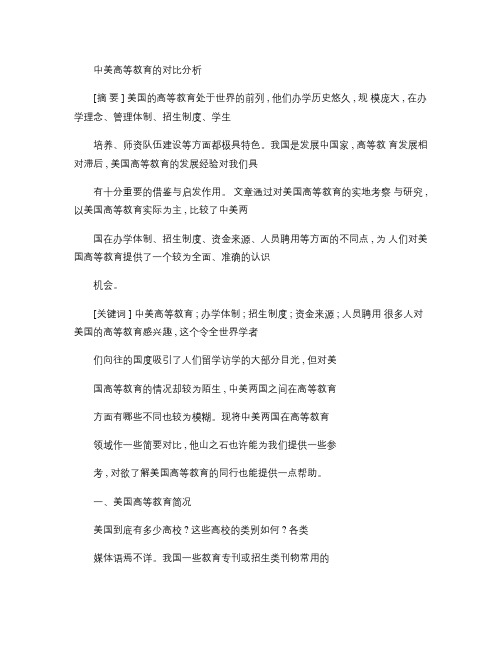
中美高等教育的对比分析[摘要 ] 美国的高等教育处于世界的前列 , 他们办学历史悠久 , 规模庞大 , 在办学理念、管理体制、招生制度、学生培养、师资队伍建设等方面都极具特色。
我国是发展中国家 , 高等教育发展相对滞后 , 美国高等教育的发展经验对我们具有十分重要的借鉴与启发作用。
文章通过对美国高等教育的实地考察与研究 , 以美国高等教育实际为主 , 比较了中美两国在办学体制、招生制度、资金来源、人员聘用等方面的不同点 , 为人们对美国高等教育提供了一个较为全面、准确的认识机会。
[关键词 ] 中美高等教育 ; 办学体制 ; 招生制度 ; 资金来源 ; 人员聘用很多人对美国的高等教育感兴趣 , 这个令全世界学者们向往的国度吸引了人们留学访学的大部分目光 , 但对美国高等教育的情况却较为陌生 , 中美两国之间在高等教育方面有哪些不同也较为模糊。
现将中美两国在高等教育领域作一些简要对比 , 他山之石也许能为我们提供一些参考 , 对欲了解美国高等教育的同行也能提供一点帮助。
一、美国高等教育简况美国到底有多少高校 ? 这些高校的类别如何 ? 各类媒体语焉不详。
我国一些教育专刊或招生类刊物常用的说法是 3000多所。
华盛顿大学 (University of Washington招生办主任菲利普〃巴凌格教授 (Philip Ballinger.Ph.D在“美国高校本科招生制度”的专题讲座中 , 介绍了美国高校的准确数据。
据巴凌格教授介绍 , 在 2007年 , 美国共有 4276所高等学校 , 总共录取了 1750万名学生 (包括社区学院转学生、外国留学生。
相当于我国大陆同年招收各类大学生的三倍左右。
美国总人口只有三亿 , 只是我国人口的四分之一不到 , 几乎人人都有读大学的机会。
在这 1750万学生中 , 公立四年制大学 640所招收学生 684万人 , 私立四年制大学1942所招收学生 416万人 , 公立两年制学院 1053所招收学生 618万人 , 私立两年制学院 528所招收学生 30.2万人。
大学中西方高等教育体制差异英语作文

大学中西方高等教育体制差异英语作文Differences Between Higher Education Systems in Chinese and Western UniversitiesIntroduction:Higher education plays a crucial role in shaping individuals' talents and skills, as well as promoting social and economic development. Chinese higher education has been rapidly expanding and developing in recent years, while western higher education has a long-standing tradition and rich experience. This article will explore the differences between the higher education systems in Chinese and Western universities.Curriculum and Teaching Methods:In Chinese universities, the curriculum is often fixed and uniform for all students in a particular major. Courses are usually taught in a lecture format, with little room for student input or discussion. In contrast, western universities often offer a more flexible curriculum, allowing students to choose their own courses and delve deeper into their interests. Teaching methods in western universities are more interactive, with professors encouraging students to participate in discussions and group projects.Assessment:In Chinese universities, students are often evaluated based on standardized tests and exams. The emphasis is on memorizing facts and regurgitating information. In western universities, assessment is more varied, including essays, presentations, and group projects. Critical thinking and analytical skills are highly valued in western higher education.Research and Innovation:Western universities place a strong emphasis on research and innovation, with professors and students actively engaged in cutting-edge research projects. Chinese universities are also increasing their focus on research, but traditional teaching methods and bureaucratic hurdles can sometimes hinder innovation.Funding and Resources:Western universities generally have more funding and resources compared to Chinese universities. This allows them to attract top talent, conduct groundbreaking research, and provide state-of-the-art facilities for students. Chinese universities are working towards improving their funding and resources, but there is still room for growth in this area.Internationalization:Western universities are known for their international outlook, with a large number of international students and academic collaborations with institutions around the world. Chinese universities are also becoming more internationalized, with an increasing number of international students and partnerships with foreign universities.Conclusion:Overall, there are significant differences between the higher education systems in Chinese and Western universities. Both systems have their strengths and weaknesses, and there is much that each can learn from the other. By fostering collaboration and sharing best practices, universities around the world can work towards providing a high-quality education for all students.。
中国和美国高等教育之间的差异(英文)
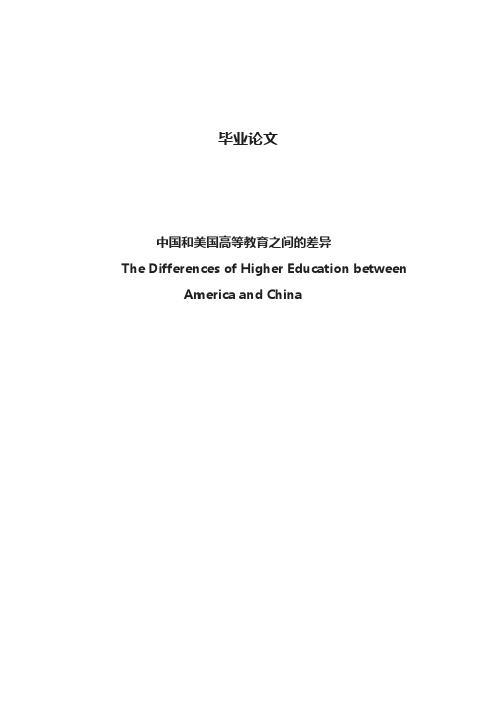
毕业论文中国和美国高等教育之间的差异The Differences of Higher Education between America and ChinaAbstractH igher education is an important approach to cultivate talented person. Different countries have different system of higher education. This paper aims at discussing the differences of higher education between China and America, and it not only puts forward the contrast analysis on the social environment, cultural tradition, education system and graduates ‘ability between China and America, but also analyzes the differences of the education reform measures between these two countries.Key words: Higher education; Difference; America; China中文摘要高等教育是培养人才的重要手段。
不同国家拥有不同体制的高等教育。
本文旨在讨论中、美两国高等教育的差异,它不仅提出了中、美两国社会环境和文化传统,教育制度和毕业生能力的对比分析,还分析了这两个国家教育改革措施的差异。
关键词:高等教育;不同; 美国;中国Contents:I. IntroductionII. Chinese-American social environment and cultural tradition differences2.1 Differences of attitudes on cultureIII. Chinese-American education system differences3.1 Different establishments of curricula and specialty3.2 Different choices of specialty curricula3.3 Different styles of inspecting students’ result3.4 Different styles of students’ management3.5 Different methods of teaching lessons3.6 Differences between public and private schoolsIV. Chinese-American graduates’ ability differences4.1 Differences of actual talents fosteredV. Chinese-American education reform measures differences 5.1 American reform measures5.2 Chinese reform measuresVI. ConclusionThe Differences of Higher Education between America and ChinaI. IntroductionIt is well known that higher education has been more and more significant all over the world. Because of the development of science and technology, the relationship between higher education and national politics, economy, science, culture, military is becoming closer and closer day by day. This mutual relation especially shows in aspect of higher education. The higher education is vigorous and upward, and it not only simply shows the growth of quantity, but especially has had the huge change in the nature. China and America share many characteristics in higher education. However this paper has mainly discussed the differences between Chinese and American higher education. The two countries are different in four significant aspects: (1)social environment and cultural tradition (2)education system (3)graduates ’ability (4)education reform measures.II. Comparison of the social environment and cultural tradition between China and America2.1 contrast of social environment and traditional education between China and AmericaAmerica is the biggest immigrant country. American economy emphasizes on the practical value, as well as individual value realization with fast development, rich material life, strong material idea and etc. The American advocates the independent way of life and work. The American owns full creative humanities spirit, the innovation is the forever subject in their brains. They pursue the hi-tech and prefer to compete.C ontrast with young USA, China is the great nation with glorious history and cultural traditions. The Chinese people have the excellent moral of modesty, but also have been over cautious and conservative. Though Chinese economy and technology is quite backward, it has very strong potential development, and Chinese students worked hard since they were small. Therefore China implements the policy of opening up, abundantly absorbs the benefit and enriches itself.The education between Chinese and American is extremely different. American education aims at building such an education to raise the creativity with less study and more thought. USA pays great attention to train the students’ practice ability to utilize the knowledge, cultivatingthe students to ask the knowledge and authority and building the ability to extend the knowledge system. That fact that 1/3 of numbers among all Nobel Prize winners in the world are the American is a very good illustration.Compared with American higher education, China’s higher education aims at building the foundation of education with more study and less thought; Chinese education pays more attention to instill and accumulate knowledge, cultivating the students’respect to the knowledge and authority and building the ability to inherit the knowledge system.III. Contrast of higher education system between Chinese and American3.1 different establishments of curricula and specialtyA nation’s higher education is the reflection of economic system. American education aims at adapting for society demand, they explicitly stipulate three big functions: education’s service for the economic development, the scientific research and teaching. The manifest of service in the establishment of specialty curriculum is to meet the social need and set up special curriculum or specialty which the society needs.In China's universities, during quite long period of time, the establishment of specialty curriculum lacks the change and could not follow social demand. In the latest few years, the majority of Chineseuniversities all started to pay great attention to the transformation and renewal of establishment of specialty curriculum so as to meet the need of society.3.2 different choices of specialty curriculaIn order to adapt the society, the American universities have established many specialties and curriculum of choice for students; the students choose or transform specialties and schools according to own interest and hobby. The American higher education system is extremely diverse and flexible, which is solo in the world higher education.In China, the student may choose the specialty according to own interest and hobby, but change of specialty in the school is not easy, transformation of school then is more difficult. In American universities, the compulsory courses are few, and elective courses are rich. While in Chinese universities, the compulsory subjects occupy the major part, and many schools(especially for technical colleges and universities)have the phenomenon of more emphasizing on the Science subjects, little on the liberal arts.3.3 different styles of inspecting students’ resultWhen American school inspects the result of student, they emphasize more on the ability to analyze and solve the question but not the ability of memory or description. The American student need the mechanical memorizing, but displays creative thought as far aspossible .This can cultivate students’study interest, raise the ability of doing it by self and make the study be one kind of creative activity.However, many teachers still adopted old teaching ways in Chinese universities, thus takes a test which needs mechanical memorizing. Such an inspection method has seriously attacked the students’ enthusiasm of study, caused the student to one-sidedly pay great attention to the theory and neglect the ability of practice.3.4 different styles of students’ managementIn the United States, many students at the school could conveniently take the IC card with a photo; the cards can be used to enter libraries and computer rooms and other facilities such as gymnasiums and other coliseum throughout the academy. Experienced consultants equipped by the school would help students to determine their main direction (major, a bit like our domestic professional) and guide students to choose specific classes. After selecting courses, in accordance with the school timetable, the septic time, place, classroom and course is entirely controlled by individual who means that everyone has the right of their own curriculum.Unlike American students, Chinese students also need arrangements of classes and dormitories. Compared with the USA’s IC card, our domestic student card and library card is similar to it. Except these, Chinese school has no experienced consultants to help students todetermine their main direction. As for the accommodation of students, some schools have a limited number of student dormitories, each school has a restaurant and fast-food shops, but most of them are always operated by outside operators where management are independent of schools. Most of students prefer to share a flat and live outside. So their dinner and lodging almost have no relationship with the school.3.5 different methods of teaching lessonsIn the United States inspiring students is great important for teaching. In classroom teachers will specially put forward some inspiring questions for students. In such a teaching mode, the students in the classroom have a higher degree of freedom, and they can be ready to make their own doubt for teachers which made the teaching atmosphere lively and vivid. This method of teaching helps to develop students’abilities of independent thinking and solving problem, however, this approach has a high demand for teachers which easily lead to a decrease in teaching quality and depth.China's higher education pays more attention to the systematic study. When teaching the curriculum, teachers should follow in accordance with certain teaching programs. Students have certain interactive questions, but this question tends to be discussed after the class, rather than in the classroom. It is the main mode that class is taught by teachers and students just listen to the records. This approachis conducive to help the students learn systematic knowledge. The class content is quite rich, but they have less sense of innovation.3.6 differences between public and private schoolsThere are more than 1500 public school of higher learning and more than 1600 private institutions in American. Both the public and private schools have a good reputation and high quality of the university. Very few Americans judge the quality not from the perspective of public and private schools, but from their teachers, courses and history.However, many Chinese believe that private schools can be unmatched with the public schools, and they are belittling or making an exclusion of private schools in heart. In private schools, Chinese people indeed should learn from the Americans, abandon the prejudice and make a correct and fair assessment for private schools.IV. Differences of quality and ability of graduates between China and US4.1 differences of actual talents fosteredIn actual talent fostered, the ability of adapting to society from American students was stronger than the Chinese Students. There are more and more opportunities to participate in social activities. Almost all the students have the experience of working outside. At the same time, civic education, campus cultural activities and community service activities in America increase the students’ability to adapt to thecommunity. While the Chinese Students stay under the closed campus for a long period,they have little direct ties to society and poorly understand the community, therefore Chinese students have to adapt to working atmosphere later than American’s students for two to three years.V.Difference of reform measures5.1 American reform measuresCurrently, American progress in the field of technology and knowledge occupies about 80 percent. The data is higher than one of the developed countries in Europe. Institutions of higher education should make indelible contribution to such a data. To meet the challenges of the 21st century, since the mid-1990s, the United States accelerates the reform of higher education systems which aimed at improving the quality of teaching and management efficiency and make greater contribution to the development of community and economy.Unprecedented expansion of social function of American University has become the power source for social development and progress. Therefore, the United States government policy-makers set off a new round of the 21st century-oriented reform of higher education to promote the development of higher education as a national goal of the important strategic initiatives.In the 21st century, the key point of American higher education reform is to achieve universal highereducation and make all over 18-year-old American youth have access to higher education.The overall idea of American Education reform is to build a higher education system which adapt to times’ demands. The most important measure is the reform of basic education and secondary education, the aim of idea is to meet the demand of adapting to the multiple reforms in future. To implement a strategic goal of universal higher education, the United States took a number of very innovative reform measures based on a substantial increase for education. These reform measures include: (1) implement small class teaching; (2) strengthen bilingual teaching, make college graduates more competitive and more adaptable; (3) improve the quality of teachers; in the system of employing teachers, schools take measures to employ formal teacher and informal teacher. In teaching methodology, teachers must adopt the modern teaching methods with integration of traditional media and modern media together for teaching.5.2 Chinese reform measuresRegarding the quality education as the most important thing, China's higher education implements the strategy of sustainable development, broaden the area of knowledge base, promote the integration of cross-disciplinary and connection between schools and society.Such a style aims at cultivating talents with a strong sense ofpioneering spirit, self-confidence, originality and boldly challenging the authority. China has been adhering to the reform of higher education for a long time. The most notable effect from the college merger is improvement of teaching effect. The College merger resolves some problems from the current teaching system uncoordinated with the international trend of socialization and market and enables educational resources to promote the effective allocation. The second measure is to set up the college courses in a market-oriented direction and adapt to the needs of society. Now in many school curricula’s is diverse, the initiative measures are taken to meet the needs of the market, at the same time a number of professionals closely related to social life are set up. The third initiative measure is based on the target of student-oriented.Since the 20th century, China's higher education emphasized the training of personnel ability, including the ability of acquiring knowledge, ability of analysis and problem-solving, ability of creating and certain organizational ability. At the same time the concept of quality education is put forward, which emphasizes the ideological and moral qualities, cultural quality, physical and mental quality. As a main part, students are not only the educated ones, but also participants of education.VI. ConclusionAll in all ,America’s higher education is different from China’s, it mainly performs through four points (1)social environment and cultural tradition (2)education system (3)graduates ‘ability (4)education reform measures. In order to reduce these differences, we should take some appropriate measures.In order to decrease the distance between Chinese higher education and American higher education, we should understand the difference of higher education between China and American, and absorb the advantages to profit from the American higher education and the development of our higher education. First of all, China's higher education should change from the "examination-oriented education" to "quality education". What is more, Chinese higher education should establish”people-oriented”education concepts. Besides, Student's sense of participation should be fully prominent in teaching practice. Teaching should focus on taking individualized teaching methods, strategies and techniques, widely apply the science teaching methods such as "free discussion", "self-study", make teachers and students exchange their ideas free, train students to learn initiative and creativity, promote students’initiative and creativity. Moreover, teaching management should achieve the reunification of system and flexibility.References[2] 丁往道,吴冰,英语写作基础教程[M],高等教育出版社,1998[1] 李泽同,透视美国[M],北京对外经贸大学出版社,2003[3] 史静寰,当代美国教育[M],北京社会科学文献出版社,2004[4] 吴明熹,教育政策的基本价值取向[J],高教研究参考,2006[5] 谢安邦,七方教育丛书[J],中国社会科学出版社,2001[6] 袁衍喜,现代教育改革探索[M],北京人民教育出版社,1987[7] 张文英,中美高等教育比较与启示[J],黑龙江高教研究,2005THANKS !!!致力为企业和个人提供合同协议,策划案计划书,学习课件等等打造全网一站式需求欢迎您的下载,资料仅供参考。
中美高等教育差异
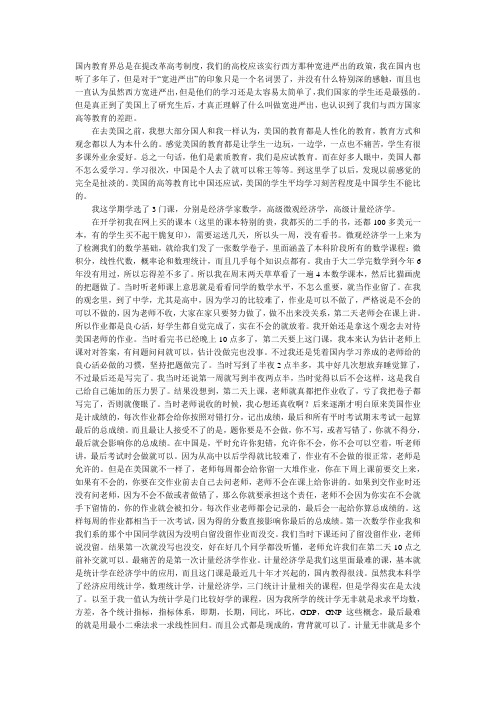
国内教育界总是在提改革高考制度,我们的高校应该实行西方那种宽进严出的政策,我在国内也听了多年了,但是对于“宽进严出”的印象只是一个名词罢了,并没有什么特别深的感触,而且也一直认为虽然西方宽进严出,但是他们的学习还是太容易太简单了,我们国家的学生还是最强的。
但是真正到了美国上了研究生后,才真正理解了什么叫做宽进严出,也认识到了我们与西方国家高等教育的差距。
在去美国之前,我想大部分国人和我一样认为,美国的教育都是人性化的教育,教育方式和观念都以人为本什么的。
感觉美国的教育都是让学生一边玩,一边学,一点也不痛苦,学生有很多课外业余爱好。
总之一句话,他们是素质教育,我们是应试教育。
而在好多人眼中,美国人都不怎么爱学习。
学习很次,中国是个人去了就可以称王等等。
到这里学了以后,发现以前感觉的完全是扯淡的。
美国的高等教育比中国还应试,美国的学生平均学习刻苦程度是中国学生不能比的。
我这学期学选了3门课,分别是经济学家数学,高级微观经济学,高级计量经济学。
在开学初我在网上买的课本(这里的课本特别的贵,我都买的二手的书,还都100多美元一本,有的学生买不起干脆复印),需要运送几天,所以头一周,没有看书。
微观经济学一上来为了检测我们的数学基础,就给我们发了一张数学卷子,里面涵盖了本科阶段所有的数学课程:微积分,线性代数,概率论和数理统计,而且几乎每个知识点都有。
我由于大二学完数学到今年6年没有用过,所以忘得差不多了。
所以我在周末两天草草看了一遍4本数学课本,然后比猫画虎的把题做了。
当时听老师课上意思就是看看同学的数学水平,不怎么重要,就当作业留了。
在我的观念里,到了中学,尤其是高中,因为学习的比较难了,作业是可以不做了,严格说是不会的可以不做的,因为老师不收,大家在家只要努力做了,做不出来没关系,第二天老师会在课上讲。
所以作业都是良心活,好学生都自觉完成了,实在不会的就放着。
我开始还是拿这个观念去对待美国老师的作业。
- 1、下载文档前请自行甄别文档内容的完整性,平台不提供额外的编辑、内容补充、找答案等附加服务。
- 2、"仅部分预览"的文档,不可在线预览部分如存在完整性等问题,可反馈申请退款(可完整预览的文档不适用该条件!)。
- 3、如文档侵犯您的权益,请联系客服反馈,我们会尽快为您处理(人工客服工作时间:9:00-18:30)。
AbstractEducation has become a symbol of the national power. Every year a great number of students from all over the world come to American for studying. On the contrary, China as an ancient country civilization with over five thousand years, only have several famous universities. This paper aims to study the difference of higher education between China and America and find out the merit of American education. Then take the essence and discard the dregs to improve the quality of our own education.Key words: Higher Education; Difference; China; AmericanIntroductionHigher education is an educational level that follows a completion of a school providing a secondary education, such as a high school, secondary school, or a gymnasium. Higher education is normally taken to include undergraduate and postgraduate education vocational education and training. Colleges, universities and institutes of technology are the main institutions that provide higher education.In many developed countries, a high proportion of the population, now enter higher education at some time in their lives. Higher education is therefore very important to national economic, both as a significant industry in its own right and as a source of trained and educated personnel for the rest of the economy. College educated workers command a significant wage premium and are much less likely to become unemployed than less educated workers.The American university has been considered as models by the world, although it only has a history of 300 years. Every year thousands of students from all over the world come to American for studying, including a large number of Chinese excellent students. With the development of economic, China also attracts a lot of oversea students in recent years, but there still are many differences on higher education between China and America. As a result, we should learn from America and make improvement in our education.I The Differences of Higher Education between China and AmericaFirstly, they are different in teaching methods.In American, inspiring students is great important for teaching. In classroom, teachers will specially put forward some inspiring questions for students. In such a teaching mode, students in the classroom have a higher degree of freedom, and they can be ready to make their own doubt for teachers which made the teaching atmosphere lively and vivid. This method of teaching helps students develop the ability of independent thinking and solving problem. However, China’s higher education pays more attention to the systematic study. When teaching the curriculum, teachers should follow in accordance with certain teaching programs. Although students have certain interactive questions, this kind of questions tend to be concentrated after the class, rather than in the classroom. It is the main mode that class is taught by teachers and students just listen to the records. This approach is conductive to help the students learn systemic knowledge, and they have less sense of innovation.Secondly, they have differences in the dependence of students. In America, college students are likely to be more independent of their parents. Students often make decisions by themselves, no matter on studying and live. And students are often expected, as part of learning to be an adult, to pay for part or all the costs of college by themselves. On the other hand, pa rents also give more freedom for children to the best of their abilities. Some American college students thrive in this new found freedom, and some flounder. Many grow up quickly during college, while others fail and leave college to find full-time jobs. In China, college students are likely to be their parents’ only child—the focus of family pride, concern, and hope. Their parents’ work hard to help them succeed, including helping them study for the dreaded college entrance exams. And parents try their best to teach traditional Confucian values of honoring family, teacher, and education and the modern realities of rapidly expanding commerce and technology.Thirdly, they have different targets. In American, every university has its reasons to exist, no matter how small it is. And each university knows what their target is. For example, the economic institute of Stanford university has three goals for undergraduate. There is no doubt the number of universities in China is increasing butmost university don’t know why it should be established and exists. Just because China has a large population, more universities can let more students go to the university. In addition, the development of Chinese universities behaves a bit impulsive, for example, many universities are seeking for certain “world rankings” but overlook the formal development of themselves. And most of students choose to go to university is to get a diploma which can help them find a job easily.II The Reasons for the DifferencesChina and America has different social environment. America is open social. The society’s openness urges the American college to abandon the old education on thought which European traditional university sticks to, adopts open policy to absorb all advantages from other countries and establishes diverse and open education control system which emphasizes the actual effects. America is the biggest immigrant country which has very strong containing nature in the culture. American economy emphasizes on the practical value, matter reward as well as individual value realization with fast development, rich material life, strong material idea and etc. The American advocates the independent way of life and work. The American owns full creative humanities spirit, the innovation is the forever subject in their brains. They pursue the high-tech and prefer to compete.Contrast with young American, China is the great nation with glorious history and cultural traditions. The Chinese people have the excellent moral of modesty, rigorous and implicit, but also have been over cautious and conservative. Through Chinese economy and technology is quite backward, it has very strong potential development. Therefore, China implements the policy of opening up, abundantly absorbs the benefit and enriches itself.Besides, Education is a cultural phenomenon, different education response to a different culture. So we can see the cultural difference in the view of higher education. From ancient on, Chinese people are always very conservative, which result in they lack of spirit of adventure and innovative conscious. As a result, the student in theclassroom is not very active. By contrast, America is a nation of immigrants with a short history. With the influence of multi culture and different values, it is easy for them to be more lively and free.III Enlightenment from the Concept of American Higher Education Nowadays, China’s higher education is shift from the examination-oriented education to quality education. Indeed what kind of education principles and practices to choose is not only related to quality of education, but related to the future of the Chinese nation and all young students’life development. The reform of higher education should respect history and national conditions with compatible absorption and innovation. Here is some enlightenment from the concept of American higher education.Firstly, teaching management should achieve the reunification of system and flexibility. Teaching management system is a set of regulations and criterions to ensure the normal functioning of teaching and extracurricular life. In the development of teaching management system, standard and uniformity nature of the system if often focused, while the humanities, reasonableness and flexibility is consider insufficiently.Secondly, students’ sense of participation should be fully prominent in teaching practice. The stress of individualized education is to awaken and mobilize students’main principle, promote students’ initiative and creativity. It not only emphasizes the lead role of teachers in the process of teaching, but also give the main role to students in the process of learning. Therefore, teaching should focus on taking individualized teaching methods, strategies and techniques, widely apply the science teaching methods.Furthermore, our education system should have appropriately change. Every university should adjust its direction and position in a timely manner with the social development, so that it keep pace with the times, and successfully transform the university into a higher level.ConclusionFrom what has mentioned above we know the differences of higher education between America and China as well as its reason. There is no point saying which kind of education is superior. We should improve ourselves continuously only if we could find out our weaknesses in this comparison and learn from the best. American higher education is the heaven for the students to learn what they like and what they need actually.Higher education in China is continuously growing, changing and developing. Higher education in China has played a significant part in economic growth, scientific progress and social development in the country by bringing up large scale of advanced talents and experts for the construction of socialist modernization. At the end of the paper lists some enlightenment from the concept of American higher education. If we can follow these changes, Chinese higher education will go to a bright future and American also can get something they lack of from our higher education.。
